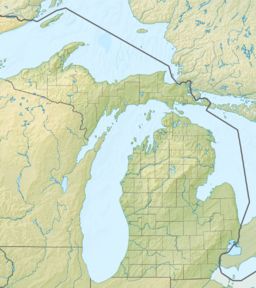Budd Lake (Michigan)
| Budd Lake | |
|---|---|
 Looking south from Wilson State Park | |
| Location | Clare County, Michigan |
| Coordinates | 44°01′22″N 84°47′48″W / 44.02278°N 84.79667°W |
| Type | Lake |
| Basin countries | United States |
| Max. length | 1.4 mi (2,300 m) |
| Max. width | 0.25 mi (400 m) |
| Surface area | 175 acres (0.7 km2) |
| Max. depth | 35 ft (11 m) |
| Surface elevation | 1,112 ft (339 m)[1] |
| Settlements | Harrison |
Budd Lake is a 175-acre (0.7 km2) lake in Clare County, in the central region of Michigan's lower peninsula.
Wilson State Park, a 36-acre wooded area with 160 campsites, borders the lake to the northwest with a sandy beach.[2] In the early 1900s century, several lumber mills operated on the Budd Lake shoreline,[3] and a lumber company that operated in the late 1800s donated Wilson State Park to Michigan.[3]
The lake is popular among anglers, particularly for its muskies, some longer than 40 inches, along with bass, panfish, perch and walleye.[4] Dropoffs near the shore provide deep water refuge; the lake is up to 30 feet deep, with the south end being shallower.[4]
There is a single public boat ramp at the southern end of the lake.
VHS Fish Disease
[edit]The Michigan DNR announced on May 17, 2007, that Budd became the first inland lake in the state of Michigan confirmed to be infected by viral hemorrhagic septicemia (VHS).[5] The DNR analyzed fish specimens after a very large die-off that began on April 30, 2007, of muskies, bluegills, and black crappie.[5] VHS is an infectious virus-spread fish disease responsible for mass die-offs of many species, but not linked to any human health concerns.[6] The disease can be spread between bodies of water through live or frozen bait fish, roe, contaminated fishing equipment, live water wells in boats, and ballast water, among other ways.[6][7] Boats and fishing equipment should be disinfected before transfer from Budd Lake to other destinations.[8]
The DNR announced that tests confirmed the continued presence of the virus in 2011, following a die-off of large mouth and small mouth bass, bluegills, and pumpkinseed sunfish in April to May 2011.[8] Fish specimens collected in May were among those used in testing the effectiveness of StaRT-PCR testing compared to cell culture and conventional qRT-PCR DNA testing, which avoided false negatives that occurred with the other techniques.[9]
See also
[edit]References
[edit]- ^ U.S. Geological Survey Geographic Names Information System: Budd Lake (Michigan)
- ^ Kevin Revolinski (2013). Camping Michigan: A Comprehensive Guide to Public Tent and RV Campgrounds. Globe Pequot Press. p. 102. ISBN 978-0-7627-8250-5. Retrieved 19 December 2013.
- ^ a b Laura Rose Ashlee (2005). Traveling Through Time: A Guide to Michigan's Historical Markers. University of Michigan Press. p. 95. ISBN 978-0-472-03066-8. Retrieved 19 December 2013.
- ^ a b Barta, Jim. "Michigan's Best Bets for Muskies". Michigan Sportsman. Archived from the original on 27 February 2009.
- ^ a b "Fish Disease Discovered in Budd Lake, Clare County (Press release)". Michigan Department of Natural Resources. 17 May 2007. Archived from the original on 14 December 2008.
- ^ a b Crawford, Franklin. Cornell researchers confirm that deadly fish virus has spread to 19 species, threatening sport-fishing industry. Chronicle Online. Cornell University. 17 May 2007. Retrieved 14 July 2007.
- ^ Phelps, NBD; Goodwin, AE; Marecaux, E; Goyal, SM (2013). "Comparison of treatments to inactivate viral hemorrhagic septicemia virus (VHSV-IVb) in frozen baitfish". Diseases of Aquatic Organisms. 102 (3): 211–216. doi:10.3354/dao02549. ISSN 0177-5103. PMID 23446970.
- ^ a b Field, Susan (14 June 2011). "Fish-killing virus found again in Budd Lake". The Morning Sun. Archived from the original on 2013-12-21. Retrieved 19 December 2013.
- ^ Pierce, Lindsey R.; Willey, James C.; Crawford, Erin L.; Palsule, Vrushalee V.; Leaman, Douglas W.; Faisal, Mohamed; Kim, Robert K.; Shepherd, Brian S.; Stanoszek, Lauren M.; Stepien, Carol A. (2013). "A new StaRT-PCR approach to detect and quantify fish Viral Hemorrhagic Septicemia virus (VHSv): Enhanced quality control with internal standards". Journal of Virological Methods. 189 (1): 129–142. doi:10.1016/j.jviromet.2013.01.006. ISSN 0166-0934. PMID 23375747. Retrieved 19 December 2013.


